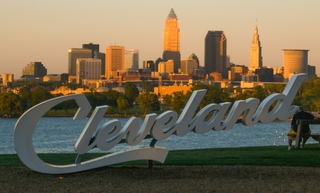
Cleveland, officially the City of Cleveland, is a city in the U.S. state of Ohio and the county seat of Cuyahoga County. Located in Northeast Ohio along the southern shore of Lake Erie, it is situated across the U.S. maritime border with Canada and lies approximately 60 miles (97 km) west of Pennsylvania.

Cuyahoga County is a large urban county located in the northeastern part of the U.S. state of Ohio. It is situated on the southern shore of Lake Erie, across the U.S.–Canada maritime border. As of the 2020 census, its population was 1,264,817, making it the second-most-populous county in the state.

The Connecticut Western Reserve was a portion of land claimed by the Colony of Connecticut and later by the state of Connecticut in what is now mostly the northeastern region of Ohio. The Reserve had been granted to the Colony under the terms of its charter by King Charles II.

Reuben Wood was a Democratic politician from the U.S. state of Ohio. He served as the 21st governor of Ohio.

The mayor of Cleveland is the head of the executive branch of government of the City of Cleveland, Ohio. As the chief executive in Cleveland's mayor–council system, the mayor oversees all city services and is "responsible for enforcing the city charter, city ordinances, and the laws of the State of Ohio." The mayor's office is located at Cleveland City Hall at 601 Lakeside Avenue in Downtown Cleveland. Since 1836, the city has had a total of 54 mayors, including the city's current mayor, Justin Bibb, encompassing 58 mayoral administrations, as four mayors have served in non-consecutive terms.

Moses Cleaveland was an American lawyer, politician, soldier, and surveyor from Connecticut who founded the city of Cleveland, Ohio, while surveying the Connecticut Western Reserve in 1796. During the American Revolution, Cleaveland was the brigadier general of the Connecticut militia.
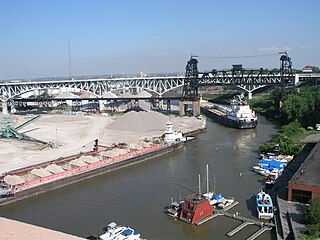
The Flats is a mixed-use industrial, recreational, entertainment, and residential area of the Cuyahoga Valley neighborhood of Cleveland, Ohio, U.S. The name reflects its low-lying topography on the banks of the Cuyahoga River.

Downtown Cleveland is the central business district of Cleveland, Ohio. The economic and symbolic center of the city and the Cleveland-Akron-Canton, OH Combined Statistical Area, it is Cleveland's oldest district, with its Public Square laid out by city founder General Moses Cleaveland in 1796.

The written history of Cleveland began with the city's founding by General Moses Cleaveland of the Connecticut Land Company on July 22, 1796. Its central location on the southern shore of Lake Erie and the mouth of the Cuyahoga River allowed it to become a major center for Great Lakes trade in northern Ohio in the early 19th century. An important Northern city during the American Civil War, Cleveland grew into a major industrial metropolis and a gateway for European and Middle Eastern immigrants, as well as African American migrants, seeking jobs and opportunity.

Ohio City is one of the oldest neighborhoods in Cleveland, Ohio. It is located immediately west of the Cuyahoga River.
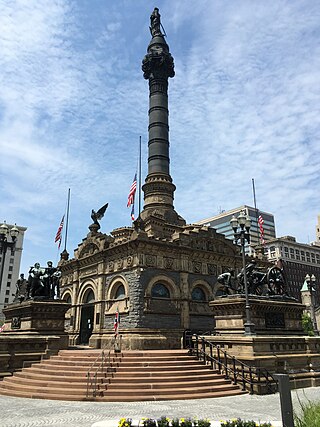
The Cuyahoga County Soldiers' and Sailors' Monument is a major Civil War monument in Cleveland, Ohio, honoring the more than 9,000 individuals from Cuyahoga County who served the Union throughout the war. It was dedicated on July 4, 1894, and is located on the southeast quadrant of Public Square in Downtown Cleveland. It was designed by architect and Civil War veteran Levi Scofield, who also created the monument's sculptures. The monument is regularly open to the public, free of charge.

Cuyahoga County, Ohio, United States is divided into 21 townships.

Settlers Landing station is a station on the RTA Waterfront Line in Cleveland, Ohio. The station is located just south of the intersection of West Superior Avenue and Old River Road inside Settlers Landing Park, after which the station is named.
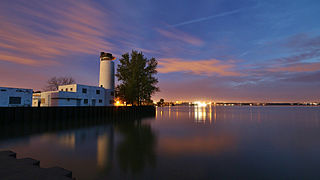
Whiskey Island is a peninsula at the mouth of the Cuyahoga River at Lake Erie in Cleveland, Ohio. Its current configuration was created in 1827 when the river's mouth was moved to its present location. Part of the city's Cuyahoga Valley neighborhood, the peninsula is 1 mile (1.6 km) long and 0.3 miles (0.48 km) at its widest, bounded by Lake Erie to the north, West 54th Street on the west (roughly), and the Cuyahoga River to the south and east.

Levi Tucker Scofield was a prominent architect and sculptor from Cleveland, Ohio. He served as a Captain in the 103rd OVI in the American Civil War and designed many public buildings and several monuments during his career. He was a third generation Cleveland resident and the Schofield Building, which he designed, is named after him.

This article is a timeline of the history of the city of Cleveland, Ohio, USA.

David Hudson was an American businessman noted for founding Hudson Township, the present-day Hudson, Ohio. Hudson was born in Branford, Connecticut, and lived there until the age four when his family moved to Goshen, Connecticut. He lived in Goshen for many years, owning a farm, marrying Anna Norton in 1783 and raising the oldest seven of their nine children there. In 1789, Hudson joined a group to purchase a parcel of land in the Connecticut Western Reserve. The following year, he left Goshen to survey the parcel and settle it as Hudson Township. Hudson traveled through the state of New York, west along Lake Erie and south along the Cuyahoga River to reach his land.

Erie Street Cemetery is a historic cemetery in downtown Cleveland, Ohio. It is the city's oldest existing cemetery.
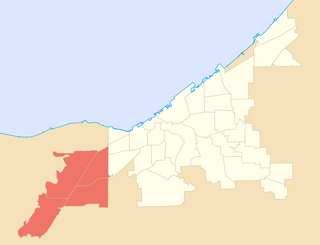
West Park is a historical area on the West Side of Cleveland, Ohio. Once an independent municipality, it was annexed by Cleveland after a referendum in 1923. The area covers 12.5 square miles and is bounded by West 117th Street to the east, the Rocky River Valley to the west, Brookpark Road to the South, and the streetcar suburb of Lakewood to the north. The Cleveland City Planning Commission traditionally divides West Park into four neighborhoods: Jefferson, Kamm's Corners, Bellaire–Puritas, and Hopkins.

The economy of Greater Cleveland is diverse, but is based on healthcare, banking, finance, education, insurance, manufacturing, sports, and tech. The metropolitan area based in Cleveland is the 33rd largest in the country, and is home to over 2 million people.




















